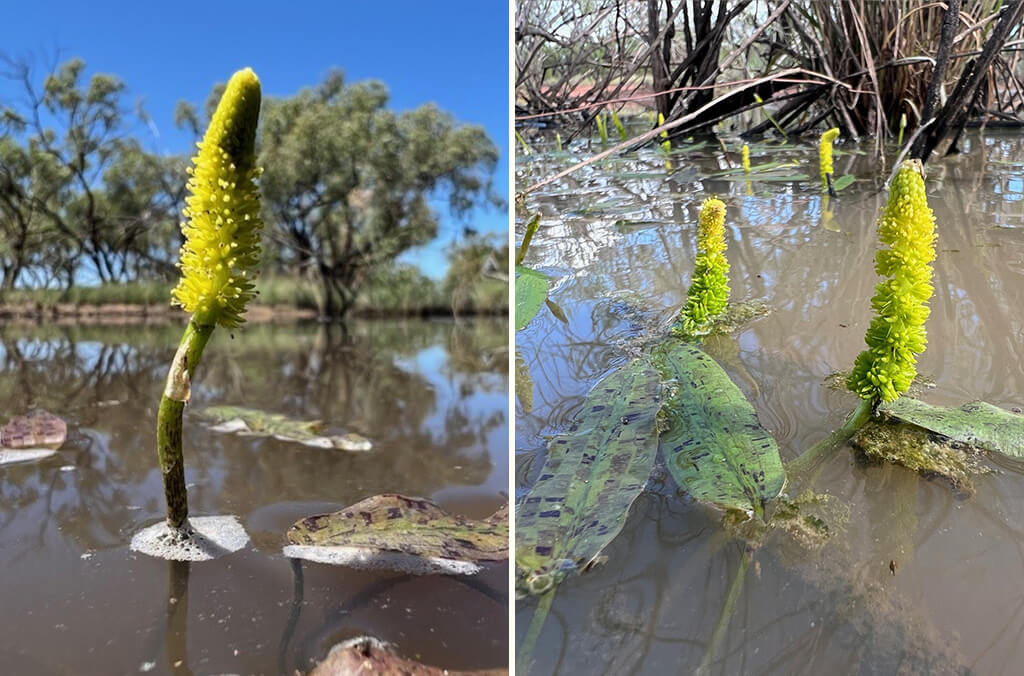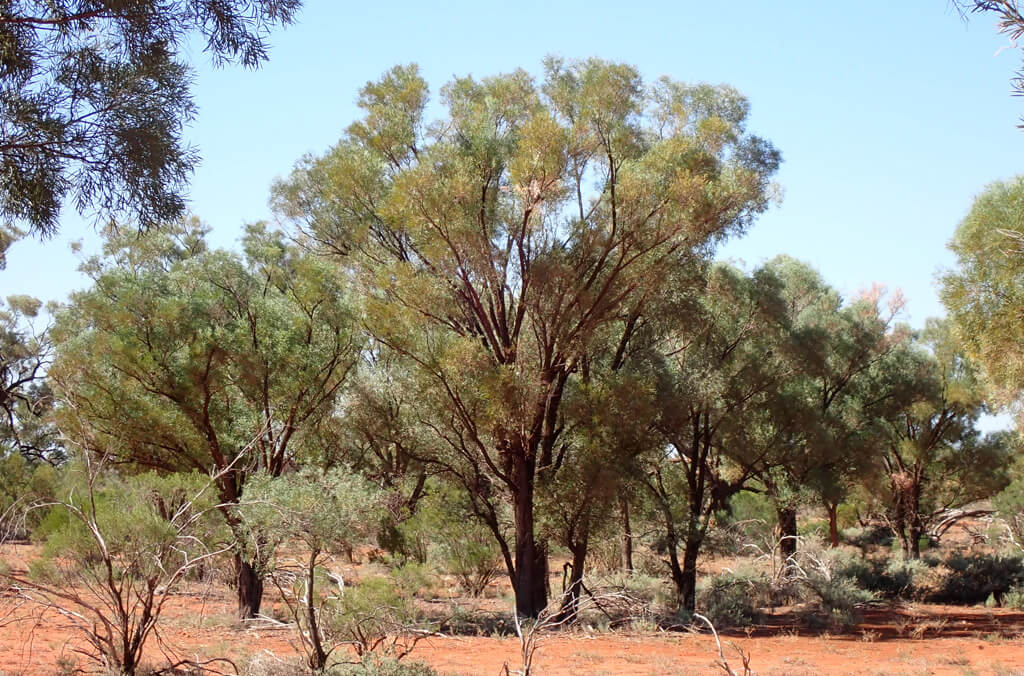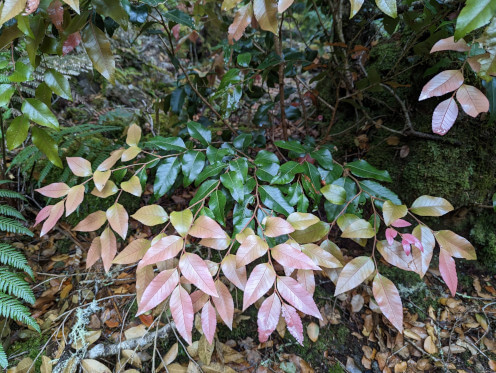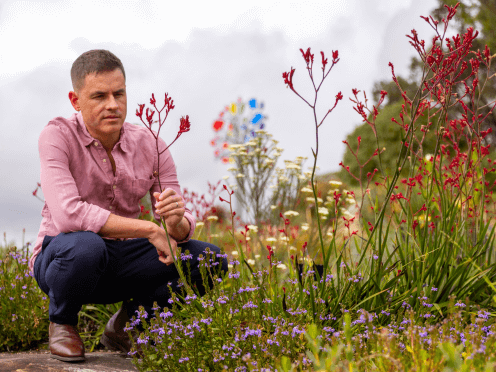The holy grail: Scientists collect seeds from rare aquatic plant
Seeds from an endangered and elusive plant species that only grows in an transient swamp west of Bourke have been secured at the Australian PlantBank for the first time.
Aponogeton queenslandicus
For years, Botanic Gardens of Sydney scientists have been waiting for a rare, ‘holy grail’ species to flower in the wild so its seeds can be secured at the Australian PlantBank. The species, Aponogeton queenslandicus, is a small aquatic plant that emerges from muddy waters with fluorescent green-yellow flowering spikes. The plant is only known to exist in one location in the state – an ephemeral swamp west of Bourke.
The transient nature of the species, which is Endangered in New South Wales, means it has a high risk of local extinction due to the increasing number and intensity of drought conditions. It relies on flooding events to grow and reproduce and disappears immediately when swamps dry up.
Last summer, scientists heard from collaborators on the ground that it was blooming quickly in a drying freshwater swamp. With no successful seed collections of this species from New South Wales ever taken before, the team from the Australian PlantBank swiftly set out to the region, in what might be the only chance to secure its seeds.
Flooding creates momentary swamps west of Bourke, where A. queenslandicus temporarily blooms.
Racing against the clock
After hearing of its appearance in March 2024, and the likelihood of returning drought conditions, the team had to act fast. The temperature at Bourke was keeping above 35°C with little signs of rain to maintain the water level in the swamp.
Collaborating with staff from the New South Wales National Parks and Wildlife Service and the Department of Climate Change, Energy, the Environment and Water - Botanic Gardens of Sydney scientists set off on a 900km journey to Nocoleche Nature Reserve.
“We were racing to get it and when we got there I saw why, it was like you could see the wetland shrinking before your eyes,” said Seedbank Officer from Botanic Gardens of Sydney, Ruby Paroissien.
“Where the water had already dried up, even though the mud was still soft, the Aponogeton was dying fast, discoloured leaves frying in the sun.”
The team sweated through the extreme heat and waded through muddy waters to collect samples of the plant.
Seedbank Officer Ruby Paroissien wading through the west swamplands of Bourke in search of A. queenslandicus.
“It was the only ephemeral swamp that still had water in it. We were sweltering in our waders for a whole day to collect it,” said Biodiversity Sampling Officer from Botanic Gardens of Sydney, Stefanie Carusi.
“If we had left it a week or so longer, I fear we would have been met with a dried-out swamp with no seeds to collect,” she said.

Scientists have waited years to collect seed from Aponogeton queenslandicus. Credit: James Faris
Years in the making
This wasn’t the first attempt to secure A. queenslandicus seeds. After the drought-ending rains in 2020, the team visited Nocoleche Nature Reserve in high hopes of finding the species.
“Despite looking around in the swamp something about the timing or conditions wasn’t quite right,” said Collections Development Coordinator from Botanic Gardens of Sydney, Laura Watts.
“We left that trip wondering if, or when, we might ever have a chance to see A. queenslandicus in the wild and have an opportunity to secure a conservation collection of it,” she said.
Scientists worked to collect samples in extreme heat, competing with the swamp drying out.
It’s one of many ‘holy grail’ status species scientists are searching to secure inside the Australian PlantBank in the seed vault. Several interacting factors are involved when prioritising plants that gain such a status:
- It occurs in areas that experiences ‘boom’ and ‘bust’ periods that are driven by climate.
- Its extinction risk is high as it is only known from one or few locations.
- Scientists have little idea what suite of environmental factors allow the species to germinate, grow, reproduce and disperse.
Securing the ‘holy grail’
After hastily travelling to the west region of Bourke and successfully collecting seed and several plants of A. queenslandicus, scientists are now relieved to finally store them at the Australian PlantBank, Australia’s largest conservation seedbank that holds 13,000 seed collections.
Timing a seed collection of any species can be challenging, but A. queenslandicus presented a wide range of obstacles with such specific, and unknown, conditions required for germination, flowering and fruiting.
“To collect from species like Aponogeton queenslandicus you must be in the right place at the right time, if we miss it, we may not see if for another 20 years,” said Paroissien.
“With unpredictable weather only becoming more likely, being able to collect seed from it ensures a safeguard for its uncertain future.” - Ruby Paroissien, Seedbank Officer at Botanic Gardens of Sydney.
“Now that we have seed and genetic material from this species, we will be able to conduct important research to hopefully demystify the complex conditions required to trigger germination for this species, a necessary step to ensuring its survival from uncertain future climatic conditions."

The increasing frequency and intensity of droughts has caused A. queenslandicus to become endangered.
At the Australian PlantBank is Australia’s largest conservation seedbank, with around 13,000 seed collections held in long-term storage. With an aim to store genetically representative seeds from all New South Wales flora, the stored collections are an insurance against extinction in the wild. The Seedbank holds more than 72% of the threatened flora of NSW.
Related stories

For the team at the Research Centre for Ecosystem Resilience (ReCER), a request from the Blue Mountains Botanic Garden to design a hedge of the towering Nothofagus moorei, or Antarctic beech, sparked a unique collaboration between science and horticulture.
In the lower Hunter Valley, a new nature reserve named Tiraki – Wonnarua for ironbark – has become a sanctuary for one of Australia’s rarest plants.

In this new episode of What the Flora!? discover why this world-first global ‘Tree of Life’ study is a new milestone in understanding the evolutionary history of flowering plants.